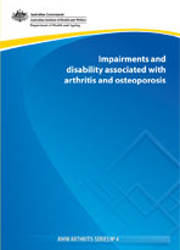Summary
Arthritis and osteoporosis are significant contributors to disability, with almost 16% (in 2003) of Australians with a disability reporting one of the two to be their main disabling condition. These conditions not only limit a variety of activities of daily living but also impact upon the independence of affected persons, affect employment choices, and contribute to reduced quality of life.
Disability associated with arthritis and osteoporosis results from a variety of impairments. These include reduced mobility of joints, pain (acute or chronic) and body stiffness. In osteoarthritis, the most common form of arthritis, the hands, spine and weight-bearing joints such as hips, knees and feet are affected. Rheumatoid arthritis, another common form of arthritis, affects considerably more parts of the body including the hand joints, fingers, toes, wrists, knees, elbows and ankles. Impairments associated with osteoporosis are mostly the result of fractures or fracture-related complications. People with osteoporosis may sometimes experience chronic, ongoing pain, but this particular impairment is usually only prominent in people who have experienced spinal fractures.
This report provides an overview of the impairments and disability associated with arthritis and osteoporosis. Impairments leading to disability are described in terms of activity limitation, problems at work and social participation. A wide range of quality of life issues and adaptation methods are also reviewed. Quantifying these aspects helps to monitor poor health outcomes associated with arthritis and osteoporosis.
Preliminary material: Acknowledgments; Abbreviations; Key findings
1. Introduction
- Structure of the report
- Theoretical framework
- Operationalising disability
- Disability data presented in this report
- Arthritis, osteoporosis and disability in the Australian population
2. Disability associated with arthritis and osteoporosis
- People with disability associated with arthritis
- People with disability associated with osteoporosis
- Summary
3. Impairments and activity limitations
- Physical impairments
- Activity limitations
- Summary
4. Health-related quality of life
- QoL and HRQoL
- Life satisfaction
- Psychological effects
- Self-reported health status
- Summary
5. Environment and adjustments
- The environment
- Use of assistive devices
- Home modifications
- Workplace modifications
- Assistance from carers
- Summary
End matter: References; List of tables; List of figures



